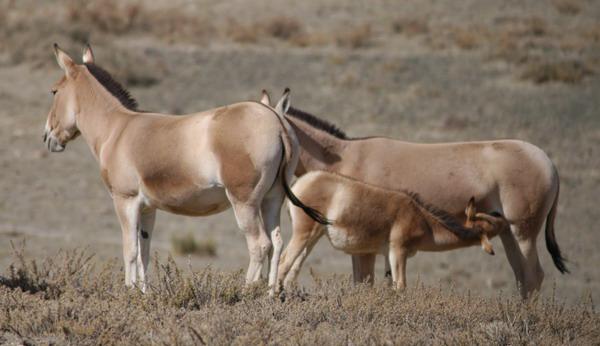The Asian wild ass consists of six subspecies, of which the Syrian wild ass is extinct.
Mongolian Wild Donkey (Near-Threatened)
Syrian Wild Donkey (Extinct)
Turkmen wild ass (endangered)
Persian Wild Ass (Endangered)
Indian Wild Donkey (Near-Threatened)
Tibetan Wild Donkey (Low Risk)

The Tibetan wild ass is a large equine mammal with an average shoulder height of 140 cm. Slightly larger than domestic donkeys, it inhabits areas between 3600 and 5400 meters above sea level. The Tibetan wild donkey is one of the successful cases of wildlife protection in China in recent years. The Tibetan wild donkey is mainly distributed in Yushu, Haibei and Haixi Prefectures in Qinghai, Aksai, Sunan, Nanbei and Maqu in Gansu, Arjin Mountain in Xinjiang, and also in northern Tibet and western Sichuan.
Due to habitat loss and the threat of poaching, most subspecies of wild donkeys are at risk of extinction. Tibetan wild donkeys have the habit of living in groups, most of which are composed of 5 or 6 small groups, the large groups are more than 10 heads, and the largest group can reach hundreds, with a male donkey as the leader of the group, leading the female donkey and the young donkey to live a wandering life together all year round. Extremely resistant to cold, sun and snow. Good at running, high vigilance. Prefers to eat thatch, moss and artemisia.
The Tibetan wild donkey is a very good desert area explorer, in the drought and lack of water, the Tibetan wild donkey will look for groundwater in the river bend, and use its hooves to plan a large puddle in the riverbed. In addition to drinking themselves, these puddles also provide water for animals such as Tibetan antelopes. The color of the Tibetan wild donkey changes with the seasons. As a rule, it is reddish brown in summer, pale yellowish brown in winter, and white or light yellow in the lower part. Wild donkeys' main predators include wolves, snow leopards, and lynx.
Video loading...